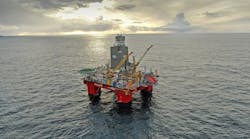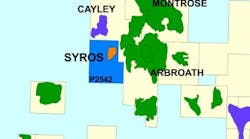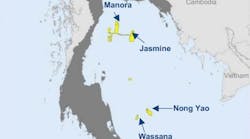Offshore staff
HAMILTON, Bermuda -- Seadrill expects to take delivery this year of nine newbuild rigs, comprising two ultra-deepwater drillships, five high-spec jackups, one tender rig, and one harsh environment jackup.
Next year the company should receive four ultra-deepwater drillships from the Samsung yard in South Korea, followed by two new harsh environment semis and four high-spec jackups in 2015.
Ten of the 19 newbuilds already are on long-term contracts following delivery. Seadrill’s remaining yard installments for its newbuilds amount to $5.8 billion, while it has so far paid $1.7 billion to the yards in pre-delivery installments.
This April the company signed a three-yearcontract with LLOG for the ultra-deepwater drillship West Neptune, which will mobilize to the Gulf of Mexico in spring 2014 following delivery from Samsung. The agreed day rate is $570,000 and LLOG has an option to extend the contract by one year.
Offshore Vietnam, Seadrill has secured eight-month extensions with Vietsovpetro for the high-spec jack-upsWest Ariel and West Prospero at a day rate of $162,000.
Utilization of the global ultra-deepwater fleet remains at 100%, the company adds. Only two of the 21 new units due to be delivered this year remain available, while 15 of the 21 newbuilds joining the market next year are without a fixed contract.
However, most of theuncommitted units are the subject of contract discussions and the fleet will likely remain 100% booked. With only 11 new units due to be delivered in 2015 and more ultra-deepwater development drilling in prospect, the market could tighten further.
In 1Q 2013 Africa and the US Gulf of Mexico were the main regions for ultra-deepwater contracts and that trend should continue through the remainder of the year, Seadrill says, supported by incremental demand from Asia, Brazil, and the Mexican sector of the Gulf of Mexico.
The company foresees increasing diversity of contract terms in the ultra-deepwater market, with relatively short-term exploration drilling programs and activity from small and mid-size independents counterbalanced by long-term development drilling campaigns and the majors’ exploration needs.
Seadrill adds that the investment in sixth and seventh generation ultra-deepwater drilling units is further justified by the fact that numerous operators are replacing fourth and fifth generation deepwater units with modern equipment to meet new requirements and expand their operation’s safety margins.
Demand for premium jackups – designed to operate in water depths up to 350 ft (107 m) and built after 2005 - remains strong, the company says, with utilization above 95% for the past year, and demand increasing during each successive quarter.
Another trend is that jackup contracts are being signed earlier and have longer terms than was the case a year ago. Seadrill has seen several contracts executed with durations of three to seven years.
Demand is strongest in Asia and the Middle East and likely to stay that way for the time being, with growing needs from Pemex in Mexico and from majors seeking to replace aging units offshore West Africa.
Higher spec jackups provide improved efficiency and safety, but there is also rising demand for units to drill HP/HT wells, i.e. with higher pressure capacities and greater deck space.
This has led to an increased number of cold stacked older-style jackups since late 2012.
Seadrill expects further contract awards in the North Sea, where the trend is toward very large, high spec harsh environment jackups.
5/31/2013




